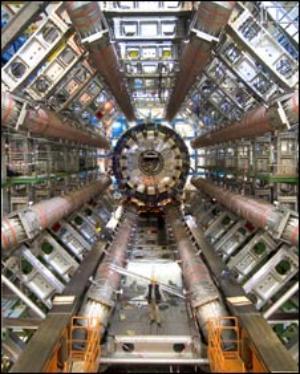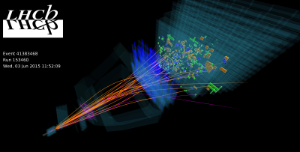Large Hadron Collider physics data collection begins again
Published: 3 June 2015
University of Glasgow scientists are welcoming the restart of physics data collection at CERN’s Large Hadron Collider (LHC) in Geneva.
University of Glasgow scientists are welcoming the restart of physics data collection at CERN’s Large Hadron Collider (LHC) in Geneva.
For the first time in 27 months, the LHC is now providing collisions to all of its experiments at the unprecedented energy of 13 TeV, almost double the collision energy of its first run. This marks the start of season 2 at the LHC, opening the way to new discoveries. The LHC will now run round the clock for the next three years.
Over the two-year shutdown, the four large experiments ALICE, ATLAS, CMS and LHCb also went through an important programme of maintenance and improvements in preparation for the new energy frontier.
Physicists from the University of Glasgow played a key role in the development of two LHC systems – ATLAS and LHCb. The ATLAS detector, one of the largest collaborative efforts ever attempted in the physical sciences, searches for new discoveries in the head-on collisions of protons of extraordinarily high energy. The LHCb provides a unique opportunity to study the phenomenon known as CP violation. It is one of the mechanisms within the Standard Mode of physics which accounts for the asymmetry that exists between matter and anti-matter.
Professor Craig Buttar of the University of Glasgow’s School of Physics and Astronomy said: "The switch on of the LHC with increased energy and luminosity is incredibly exciting. It will allow us to extend our searches for evidence for new physics and to study the Higgs boson to see if it behaves as expected or is a window to new physics. The ATLAS experiment has been upgraded to take full advantage of the increased energy with the installation of a new detector, the IBL, which will enhance our ability to search for the rare signatures of new physics."
Today the LHC operators declared ‘stable beams’, the signal for the LHC experiments that they can start taking data. Beams are made of ‘trains’ of proton bunches moving at almost the speed of light around the 27 kilometre ring of the LHC. These so-called bunch trains circulate in opposite directions, guided by powerful superconducting magnets. Today the LHC was filled with 12 bunches each containing around 100 billion protons. This rate will be progressively increased as the run goes on to 2800 bunches per beam, allowing the LHC to produce up to 1 billion collisions per second.
During the first run of the LHC, the ATLAS and CMS experiments announced the discovery of the so-called Higgs boson, which was the last piece of the puzzle known as the Standard Model, a theory that describes the fundamental particles from which everything visible in the universe is made, along with interactions at work between them.
With Run 2 starting today, physicists have the ambition to further explore the Standard Model and even to find evidence of new physics phenomena beyond its boundaries, which could explain remaining mysteries such as dark matter, believed to make up a large proportion of the universe, or nature’s apparent preference for matter over antimatter, without which we would not exist
Professor Anthony Doyle of the School of Physics and Astronomy said: "The Glasgow group is looking forward to Run 2 with almost three times as many collisions per second in the collider, allowing the properties of the Higgs boson and origin of the matter-antimatter asymmetry to be studied in greater detail. Run 2 will also nearly double the experiments' collision energy in order to search for higher mass resonances and probe exotic theories such as supersymmetry and extra dimensions. The next few years will be an exciting time of scientific discovery."
The University’s Dr Aidan Robson said: “The discovery of the Higgs boson at Run 1 of the LHC was only the beginning. The higher energy and collision rate of Run 2 will let us probe this particle in much more detail. By measuring the Higgs boson's properties and by searching for further new particles, I hope we will get new, fundamental understanding about the universe - for example, hints about the nature of dark matter.”
Professor Paul Soler from the School of Physics and Astronomy said: “The Standard Model for Particle Physics was completed with the discovery of the Higgs boson at the Large Hadron Collider. The University of Glasgow group has been a major contributor to the construction and physics output of LHCb, one of the four large detectors at the LHC. The next phase of data-taking at an increased energy (13 TeV) that starts today will allow us to measure with increased precision the subtle differences between matter and antimatter and to search for very rare processes that might hint at what lies beyond the Standard Model.”
Media enquiries: ross.barker@glasgow.ac.uk / 0141 330 3535
First published: 3 June 2015
<< June

